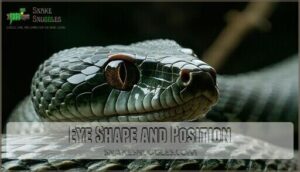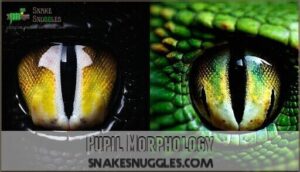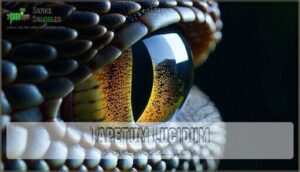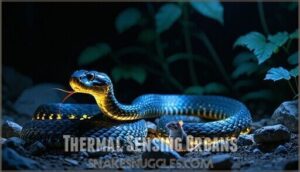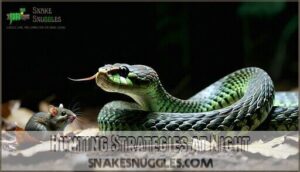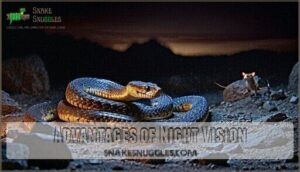This site is supported by our readers. We may earn a commission, at no cost to you, if you purchase through links.
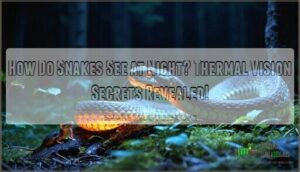
Their eyes contain specialized rod cells that capture minimal light, while some species possess heat-sensing pit organs that detect infrared radiation from warm-blooded prey.
These thermal receptors work like biological night-vision goggles, creating detailed heat maps of their surroundings.
You’ll find that pit vipers, pythons, and boas excel at this thermal detection, sensing temperature differences as small as 0.003°C.
Combined with their excellent low-light vision and chemical detection through forked tongues, snakes become incredibly efficient nighttime hunters.
The intricate mechanics behind these sensory superpowers reveal nature’s ingenious solutions, showcasing how snakes utilize their thermal detection and low-light vision to thrive.
Table Of Contents
- Key Takeaways
- How Do Snakes See at Night?
- Structure of Snake Eyes
- Nocturnal Vision Adaptations
- Thermal Sensing Organs
- Hunting Strategies at Night
- Advantages of Night Vision
- Frequently Asked Questions (FAQs)
- Can snakes see in the night?
- How can you tell if a snake is around?
- How do snakes behave at night?
- Can snakes distinguish colors in low-light conditions?
- Do all snake species have equal night vision abilities?
- How does shedding affect a snakes night vision?
- Can snakes see ultraviolet light like some other animals?
- Do snakes dream during their rest periods?
- How do blind snakes navigate at night?
- Can snakes see colors in darkness?
- Conclusion
Key Takeaways
- You’ll find snakes use specialized rod cells and vertical pupils that open wide like camera apertures – this lets them capture every bit of available light in darkness, giving them superior night vision compared to most animals.
- Thermal detection through pit organs acts like biological night-vision goggles – species like pit vipers, pythons, and boas can sense temperature differences as small as 0.003°C, creating detailed heat maps of warm-blooded prey.
- You’re witnessing master ambush predators that combine multiple senses – snakes integrate their enhanced vision with chemical detection through forked tongues and heat sensing to become incredibly efficient nighttime hunters.
- Night hunting gives snakes major advantages over their prey – they conserve energy through strategic thermal regulation while achieving higher strike accuracy rates when their warm-blooded targets rely on limited night vision.
How Do Snakes See at Night?
You’ve probably wondered how snakes hunt so effectively in complete darkness. These reptiles have evolved incredible snake vision adaptations that go far beyond ordinary sight. Their snake night vision relies on specialized vertical pupils that open wide like camera apertures, capturing every available photon. Night-hunting snakes lack UV filters, enhancing their ability to see in low light conditions.
But here’s where it gets fascinating: many species possess infrared snake vision through pit organs that detect heat signatures from warm-blooded prey. This snake heat sensing creates thermal maps of their surroundings, giving them evolutionary advantages in nocturnal hunting.
Snake eyes transform into biological night-vision goggles, detecting body heat from prey hiding in absolute darkness.
Their sensory integration combines limited color perception with chemical detection through tongue-flicking behavior. Even during brumation effects in winter, these adaptations remain essential for survival. Habitat influence shapes how different species use these remarkable abilities, making them masters of snake nocturnal behavior.
Snakes use their pit organs to detect infrared radiation.
Structure of Snake Eyes
You’ll notice that snake eyes have a unique structure perfectly adapted for their hunting lifestyle.
Their eyes sit on the sides of their head, giving them an incredibly wide field of view to spot movement from almost any direction, which is a key aspect of their hunting lifestyle.
Eye Shape and Position
Snake eyes work differently than yours. Their side-positioned eyes create an impressive field of view that spans nearly 360 degrees, giving them exceptional peripheral vision.
This eye protection comes from transparent scales covering each eye, acting like built-in safety goggles. Unlike mammals with binocular vision, snakes sacrifice depth perception for this evolutionary advantage in detecting movement and threats.
Here’s how snake eye anatomy maximizes their visual capabilities:
- Wide field of view – Side placement lets them see almost everything around them
- Movement detection – Fixed focus helps spot even tiny movements instantly
- Eye protection – Transparent scales shield eyes from debris and damage
- Streamlined design – Smooth eye structure reduces drag while moving through tight spaces
Pupil Morphology
Beyond their placement, pupil shape dramatically affects how snakes control light intake.
Most nocturnal species feature vertical slits that contract to hairline gaps in bright conditions, then dilate wide for maximum light collection after dark.
This pupil morphology provides superior visual acuity across varying illumination levels compared to round pupils.
Snakes also rely on vomeronasal organ function to perceive their surroundings.
| Feature | Diurnal Snakes | Nocturnal Snakes |
|---|---|---|
| Pupil Shape | Round or oval | Vertical slits |
| Light Control | Moderate adjustment | Extreme dilation range |
| Visual Adaptations | UV filtering | Enhanced night sensitivity |
This evolutionary advantage transforms snake vision into a precision instrument perfectly tuned for their hunting lifestyle.
Nocturnal Vision Adaptations
You’ll discover that snakes have developed remarkable adaptations to navigate the darkness effectively. Their eyes contain specialized structures that maximize available light and detect thermal signatures from warm-blooded prey.
Rod and Cone Cells
These cellular powerhouses make snake nocturnal vision possible. Rod cells dominate snake retinas, providing exceptional light sensitivity for hunting in darkness.
Most nocturnal snakes possess duplex retinas containing both photoreceptor types, while some diurnal species have transmuted rods disguised as cones. The Thamnophis proximus snake exhibits rod-to-cone transmutation, challenging previous assumptions about all-cone retinas.
- Rod function: Captures minimal light, enabling scotopic vision in near-total darkness
- Cone function: Processes bright light and limited color perception through dichromatic vision
- Visual acuity: Specialized cell distribution peaks at the area centralis for focused sight
Rod and cone cells work together during mesopic conditions, giving snakes conditional trichromacy at dawn and dusk when prey activity increases.
Tapetum Lucidum
While rod cells excel at capturing faint light, many snakes possess an additional nocturnal vision advantage.
The tapetum lucidum acts like nature’s built-in reflector, bouncing light back through the retina for a second chance at detection.
This reflective mechanism enhances snake low light vision by amplifying available photons.
However, tapetum evolution shows limited presence across snake species.
This cellular structure varies substantially between different types of nocturnal snake hunting specialists.
| Vision Feature | Snake Species |
|---|---|
| Tapetum lucidum | Some pythons, boas |
| Standard retina | Most colubrids |
| Pit organs | Vipers, pythons |
| Enhanced rods | Night hunters |
| UV filters | Day-active species |
Species variation in tapetum lucidum reflects different hunting strategies.
Snakes with this adaptation can detect prey movement in near-total darkness, while others rely on thermal sensing or chemoreception.
Snake sight capabilities depend on combining multiple sensory systems rather than relying solely on visual adaptations for successful nocturnal vision.
Thermal Sensing Organs
You’ll discover that some snakes possess remarkable thermal sensing organs called pit organs that function like biological heat detectors.
These specialized structures allow certain snake species to create thermal images of their surroundings, giving them a significant advantage when hunting warm-blooded prey in complete darkness.
Pit Organs
When hunting under darkness, snakes rely on specialized thermal sensing organs called pit organs.
These remarkable structures detect infrared radiation from warm-blooded prey, creating thermal images that function like natural night vision goggles.
The pit organ’s membrane is incredibly sensitive, capable of detecting minute temperature changes.
- Pit organ location: Positioned between eyes and nostrils in pit vipers, boas, and pythons
- Pyroelectric mechanism: Cells within pit organs use cellular voltage to detect temperature variations
- TRPA1 proteins: Abundant proteins that may enhance thermal detection capabilities
- Evolutionary advantages: Enable precise hunting in complete darkness without relying on sight
Infrared Sensitivity
Snakes equipped with pit organs possess remarkable infrared detection range capabilities.
These snake sensory organs detect infrared radiation from warm-blooded prey, creating detailed thermal imaging through specialized molecular mechanisms.
Pit viper vision exemplifies this evolutionary advantage, allowing precise strikes in darkness through thermal image processing.
| Detection Feature | Capability |
|---|---|
| Temperature sensitivity | 0.003°C changes |
| Detection distance | Up to 1 meter |
| Membrane thickness | 15 micrometers |
| Hunting success boost | 50% improvement |
This snake thermal imaging system processes infrared radiation through trigeminal nerve pathways, giving pit organ function its lethal precision in nocturnal hunting scenarios.
Hunting Strategies at Night
You’ll discover that snakes become silent hunters once darkness falls, using specialized techniques that put them at a major advantage over their prey.
Their nighttime hunting relies on two key strategies: staying perfectly still until the right moment strikes, and following chemical trails that lead them straight to their next meal, utilizing specialized techniques.
Ambush Predation
With thermal vision locked onto their target, snakes execute perfect ambush predation through stealth tactics and camouflage mastery. These patient hunters integrate sensory information to select prime prey before striking.
- Position strategically – Choose concealed spots with high prey traffic
- Remain motionless – Blend seamlessly using natural camouflage patterns
- Monitor thermally – Track warm-blooded targets through pit viper vision
- Strike explosively – Deploy lightning-fast strike speed when prey approaches
This energy-efficient snake night hunting strategy maximizes success while conserving essential resources through calculated patience. Researchers sometimes use infrared triggered devices to study these behaviors.
Chemoreception
Beyond patient ambush tactics, you’ll witness chemoreception in action through tongue flicking behavior.
Forked tongues collect chemical cues from air and surfaces, transferring molecules to specialized olfactory senses.
This scent tracking system detects faint trails left by prey, enabling accurate prey detection even in complete darkness.
Their chemoreceptive abilities complement thermal sensing for successful nighttime hunting.
Snakes use their tongues to transfer odor particles to their Jacobson’s organ for enhanced detection.
Advantages of Night Vision
You’ll discover that a snake’s night vision abilities give it significant advantages when hunting in complete darkness.
These specialized adaptations allow snakes to conserve energy while maintaining exceptional predatory success rates during nighttime hours.
Predatory Success
Although many predators struggle in darkness, snakes achieve remarkable Hunting Efficiency through Sensory Integration of thermal and chemical cues.
Their nocturnal behavior creates unique advantages:
- Strike Accuracy improves with infrared radiation detection from pit organs
- Prey Vulnerability increases when mammals rely solely on limited night vision
- Environmental Factors like cooler temperatures slow prey responses substantially
- snake prey detection combines thermal imaging with scent tracking simultaneously
- predatory success rates double during ideal nighttime hunting conditions
This remarkable ability is due to specialized TRPA1 proteins.
Energy Conservation
Night hunting isn’t just about finding prey—it’s about smart energy management.
Snakes have mastered nocturnal behavior through strategic thermal regulation that maximizes their hunting efficiency while minimizing energy costs.
Here’s how these nocturnal hunters achieve energy conservation:
- Brumation Strategy: During winter months, snakes enter a resting state where they store energy as glycogen rather than burning calories through constant movement
- Efficient Hunting: Their infrared radiation detection allows precise snake prey detection without wasted energy on missed strikes
- Thermal Sensing Advantage: Pit organs enable successful hunting in darkness, reducing time spent actively searching for food
Frequently Asked Questions (FAQs)
Can snakes see in the night?
Yes, you can spot snakes at night, but their vision is quite limited.
Most snakes see only basic colors and movement.
However, pit vipers and some boas have special heat-sensing organs that detect warm-blooded prey in total darkness.
How can you tell if a snake is around?
Like a detective following breadcrumbs, you’ll spot telltale signs: shed skin, tracks in dirt, disturbed mulch, or hiding spots like woodpiles.
Listen for rustling sounds and watch for movement near water sources or warm surfaces.
How do snakes behave at night?
Snakes become more active at night, especially nocturnal species that hunt prey. They’ll cross roads, explore yards, and use their heat-sensing pit organs to detect warm-blooded animals in darkness.
Can snakes distinguish colors in low-light conditions?
Most snakes can’t distinguish colors well in low-light conditions since they only see two primary colors compared to humans’ three.
Their night vision relies more on detecting movement and thermal radiation than color differentiation, which is based on detecting thermal radiation.
Do all snake species have equal night vision abilities?
No, night vision abilities vary substantially among snake species.
Nocturnal hunters like pit vipers have specialized thermal-sensing organs, while day-active species rely on basic light detection and movement recognition for nighttime navigation.
How does shedding affect a snakes night vision?
During shedding, you’ll notice a snake’s vision becomes cloudy and impaired because the transparent eye scale (spectacle) becomes milky-white.
This temporary blindness affects their night vision until they complete the shed.
Can snakes see ultraviolet light like some other animals?
Unlike many animals, you can’t count on snakes having ultraviolet vision.
Most snakes see only two primary colors compared to humans’ three, limiting their color spectrum rather than expanding it beyond visible light.
Do snakes dream during their rest periods?
Don’t count your chickens before they hatch regarding snake dreams.
You’ll find that snakes don’t experience REM sleep like mammals do.
Instead, they enter a conservation state where brain activity slows substantially, making traditional dreaming unlikely during their rest periods.
How do blind snakes navigate at night?
Blind snakes rely heavily on chemoreception, using their forked tongues to detect chemical trails and scent molecules.
They also use tactile sensing through specialized scales to navigate underground burrows and surface terrain effectively, which is crucial for their survival.
Can snakes see colors in darkness?
Darkness doesn’t derail a snake’s color detection – you’ll find they can’t see colors at all in pitch-black conditions.
Their limited two-color vision requires some light to function, unlike their thermal sensing abilities.
Conclusion
Like ancient sentinels equipped with invisible lanterns, snakes transform darkness into opportunity through their extraordinary sensory arsenal.
Understanding how do snakes see at night reveals nature’s remarkable engineering. Their specialized rod cells capture the faintest light while thermal pit organs detect heat signatures with stunning precision.
These adaptations create efficient nocturnal predators that combine visual, thermal, and chemical detection systems. You’ve discovered that snakes don’t just survive in darkness—they dominate it through evolutionary perfection that turns night into their greatest hunting advantage, showcasing their ability to transform night into opportunity and utilizing their senses to thrive in the dark, making them nocturnal predators.
- https://en.wikipedia.org/wiki/Infrared_sensing_in_snakes
- https://dirtyclassroom.com/ssssixth-ssssense-infrared-sensing-in-snakes-carolyn-scarpelli/
- https://www.livescience.com/959-night-vision-snakes-clear-picture-prey.html
- https://sciences.sdsu.edu/for-night-vision-snakes-see-a-clear-choice/
- https://www.pbs.org/wgbh/nova/kalahari/nocturnaleye.html

